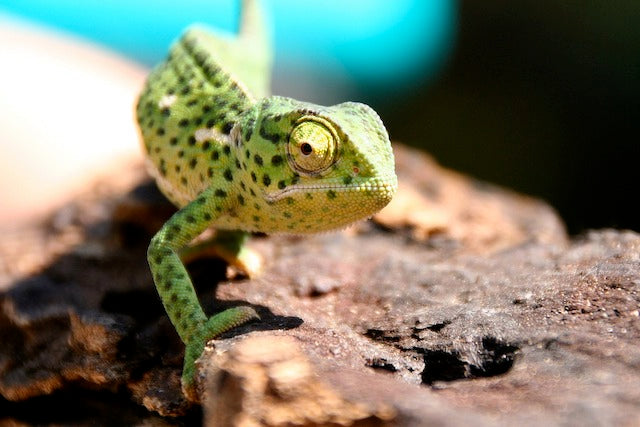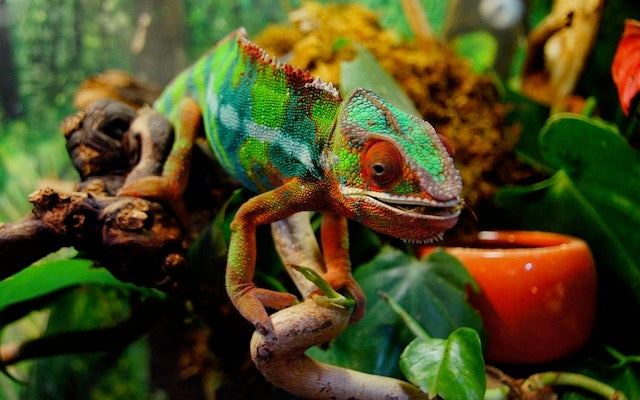Most first-time chameleon keepers – and even some more experienced keepers – want to know how long they can expect their reptile pal to live. The answer is: It depends…
Your chameleon’s lifespan is dependent on a number of factors, some of which are in your control, and some of which aren’t.
So, how long do chameleons live on average? Chameleon’s can live anywhere from just six months to around two decades.
Chameleon Lifespan In the Wild
How long do chameleons live in the wild?
This is a tricky question to answer as scientists have a difficult time observing chameleons in the wild. However, most scientists conclude that the chameleon’s lifespan in the wild is remarkably short.
Generally a wild chameleon will live somewhere between two and three years. This is in large part because they must survive numerous threats, like parasites, diseases, infections, and predators, as well as environmental dangers like deforestation.
For this reason, most wild chameleons typically reach sexual, or reproductive, maturity very quickly – usually within the first 12 months of life.
How Long Do Chameleons Live as Pets?
How long your chameleon will live as a pet is dependent, in part, on you! So long as you’re providing a fully optimized environment, highly nutritious foods, plenty of water, and regular checkups with your reptile veterinarian, you can expect your pet chameleon to reach its full life expectancy.
Factors That Affect Chameleon Lifespan
When it comes to helping your chameleon live its best and longest life, there are some things that are completely in your control, and some things that aren’t.
What You Can Do to Extend Your Chameleon’s Lifespan
Enclosure
It's important for your chameleon to have adequate space in its enclosure. The size of enclosure your chameleon needs depends on the size of your chameleon.
Remember, chameleons are tree-dwellers in the wild. Having a taller enclosure that provides ample room for climbing is just as important as having a wide enclosure that provides plenty of room to explore.
A sufficient chameleon enclosure should typically be:
- 3’ long x 3’ deep x 4’ tall for larger species
- 18” long x 18” deep x 30” tall for smaller species
Pro Tip: When choosing the size of your chameleon’s enclosure, err on the side of “bigger is better.”
Temperature and Humidity
As with leopard geckos, temperature and humidity levels also play an important role in your pet chameleon’s longevity. Chameleons are rainforest creatures. As such, they’re used to warm, humid climates.
Your chameleon’s enclosure will need a temperature gradient of between 70ºF and 80ºF on the cool side, and 80ºF and 100ºF on the warm side. You should also maintain humidity levels between 50% and 80% depending on the species of chameleon and time of day. Use a reliable fogger or automatic misting system to maintain appropriate humidity levels for your particular species of chameleon.

Feeders
Your chameleon also needs plenty of highly nutritious, gut-loaded insect feeders. Dubia roaches, crickets, and mealworms are some of the best staple feeders you can offer your chameleon. But since variety is also an important part of your chameleon’s diet, you should also offer it the occasional grasshopper, hornworm, wax worm, or other special treat as you see fit.
Pro Tip: The insect feeders you offer to your chameleon should be no larger than the space between its eyes.
Climbing Decor
As rainforest tree-dwellers, chameleons need plenty of things to climb on, as well as vegetation to hide behind. Be sure your chameleon’s enclosure includes plenty of plants and even trees for your chameleon to feel right at home.
Water
Chameleons don’t drink from water dishes. They get their water by licking droplets off of leaves. Be sure to regularly mist the plants inside your chameleon’s enclosure to make sure it gets that water it needs.
Chameleon Lifespan Issues Beyond Your Control
Even if you do everything right, there are a number of factors beyond your control that will affect your chameleon’s lifespan. These include:
- Species – smaller species tend to have shorter lifespans than larger species
- Gender – males tend to live longer than females
- Wild-caught vs. captive bred – wild-caughts chameleons make an arduous journey from the rainforests of Africa to your local pet store. Many never fully recover from the trip, and many others arrive severely dehydrated and often have parasite problems.
Pro Tip: Most pet stores “import” their chameleons, meaning they purchase wild-caught chameleons from their supplier. As soon as possible after purchasing your chameleon, book an appointment for it with your reptile or exotic pet veterinarian.
Chameleon Lifespan by Species
As mentioned above, your chameleon’s species plays a big role in how long you can expect your chameleon to live. Larger species like the Parson’s Chameleon or the Veiled Chameleon tend to have longer lifespans than smaller species like the Pygmy Chameleon or the Carpet Chameleon.
This chart may be a helpful guide as you decide which chameleon species you’d like to keep as a pet.
Chameleon Lifespan Chart
|
Chameleon Species |
Lifespan |
|---|---|
|
Jackson’s Chameleon |
3-5+ years |
|
Veiled Chameleon |
6-8+ years |
|
Panther Chameleon |
3-6+ years |
|
Parson’s Chameleon |
10-20 years |
|
Oustalet’s Chameleon |
3-7+ years |
|
Four-Horned Chameleon |
3-5 years |
|
Pygmy Chameleon |
1-2 years |
|
Carpet Chameleon |
2-3+ years |
|
Meller’s Chameleon |
5-10+ years |
|
Senegal Chameleon |
3-5 years |
|
Fischer’s Chameleon |
3-5 years |
|
Rudis Chameleon |
3-4 years |
|
Giant Spiny Chameleon |
3-5 years |
Takeaway: How long do chameleons live? It depends on a number of factors including species, gender, source of origin, and husbandry. On average, chameleons live between six months and two decades.
One key factor at play that will determine your chameleon’s lifespan is nutrition. Your chameleon needs a wide variety of highly-nutritious, gut-loaded insects as the main staple of its diet. The Dubia roaches offered by Dragon’s Diet are a great start to keeping your chameleon well-nourished, happy, and living its best life.








